INDIAN OCEAN TRAVEL by TOURISMER
INDIAN OCEAN TRAVEL by TOURISMER

Responsible travel Mozambique
A splendid journey in preserved natural parks, on paradisiacal islands, in contact with young and dynamic populations proud of their cultures.
Mozambique enjoys extraordinary biological diversity.
Now, the country's commitment to conservation and several coordinated measures are contributing to the significant decline in poaching in this biodiversity sanctuary.
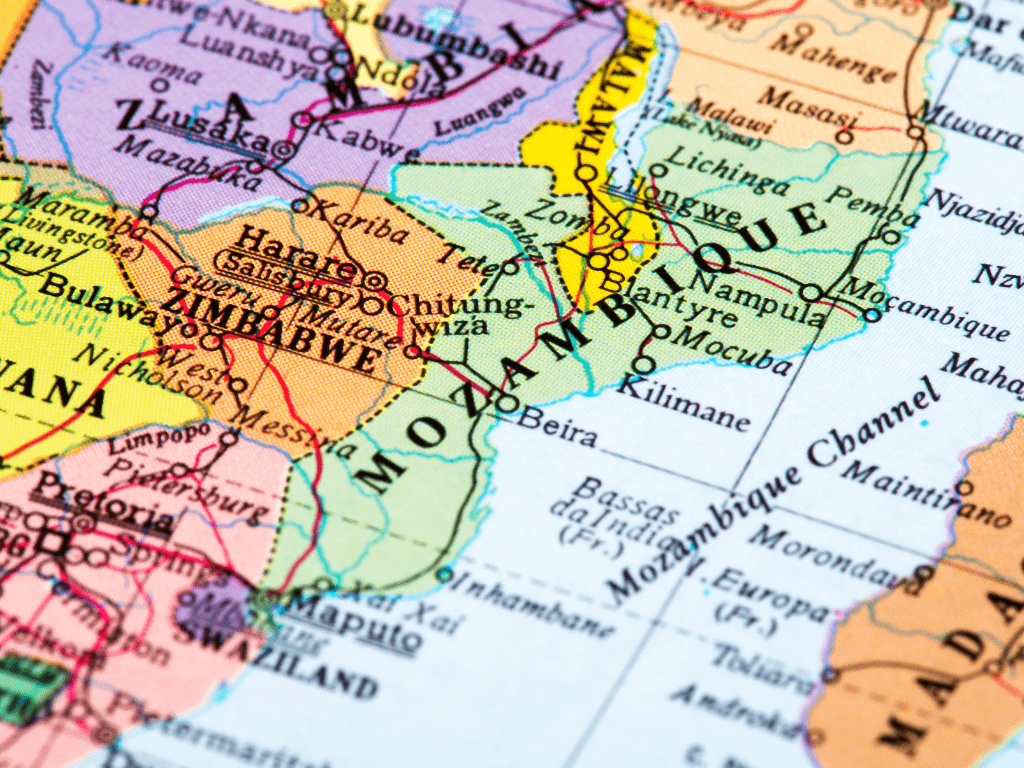

By traveling responsibly in Mozambique, you are actively contributing to the conservation of the country as well as the development of local communities.
The country is a fragile ecosystem, which has not yet structured its tourism offer, here are some common sense tips: choose lodges with a socially and ecologically responsible attitude. Visit villages and community projects (schools, hospitals, agriculture, crafts, etc.).

Even before the year 1000, many commercial exchanges were carried out with Arab traders but also from the west of the Indonesian archipelago. In 945, we see arriving on the coast of Mozambique a thousand boats manned by Waq-Waq who come from islands "facing China" to seek goods and slaves zeng, an Arabic word which at the time designated the inhabitants of the east coast of Africa.
The year 1498 marks the arrival of the Portuguese navigator Vasco de Gama. Shortly after, the Portuguese set up trading posts and built forts. The Portuguese presence lasts five centuries.
In 1964, FRELIMO launched the Mozambican War of Independence which continued for ten years.
At the end of the Mozambican War of Independence, the country obtained its independence on June 25, 1975, under the name of the People's Republic of Mozambique and became a communist regime that the former independence movement, FRELIMO, led as a single party. . Samora Machel is elected president and implements a number of reforms.
The first year of independence was full of hope, and the regime found many supporters in the socialist camp (USSR, Cuba, Yugoslavia), as in the Western left. From 1976 an armed conflict began, which degenerated into a bloody civil war. The RENAMO, anti-Marxist and supported by Rhodesia and South Africa, maintains a guerrilla which extends and causes nearly a million deaths in fifteen years.
This also drives the country into bankruptcy. It became for economists the poorest country in the world in 1986. At the end of the civil war, in 1992, the peace agreements allowed the establishment of a Western-style democracy.
In 1995, Mozambique entered the Commonwealth when it had never been administered by the United Kingdom, betting on the benefits of deeper economic integration with the six English-speaking states that surround it.
Armando Guebuza, of FRELIMO, was president from February 2005 to January 2015.
From 2017, several attacks by Islamist groups took place in the north of the country, which the government was trying to combat.
President Filipe Nyusi, candidate of the ruling party, FRELIMO, was re-elected in October 2019 for a second five-year term with 73% of the vote.
In March 2019, the cyclone Idai causes at least 650 deaths, hundreds of thousands of displaced persons, more than 1.8 million people under humanitarian assistance and considerable economic damage.
The official language is Portuguese. The different ethnic groups have their own language, most of which are Bantu languages.
The country has about 101 ethnic groups, the most important being the Makonde, the Tsongas, the Yaos and the Shonas.
the main languages are: Emakhuwa 26%, Xichangana 11%, Elomwe 8%, Mozambican Sena 7%, and Echuwabo 6.3%. As for the Portuguese language, 50.4% of the population can speak it. English is a foreign language very present among members of the country's elite.
The main religions are Christianity for 56% (including Catholicism 28%) and Islam for 17.9%, while 17.8% of the population are animists and 8.2% have no religion.
Music and dance
The Timbila Chopi is a tradition of orchestral music of the Chopi communities originating from Inhambane province Timbila are traditional wooden xylophones.

The marrabenta is popular urban music from Mozambique. She was born in southern Mozambique, particularly in the Mafalala district of Maputo in the 1930s. The marrabenta is inspired by Mozambican folk music and more modern rhythms from South Africa.
Source: http://africultures.com/
Literature
We can cite José Craveirinha, born on dead the , is a Mozambican journalist, writer and poet. He is considered the greatest Mozambican poet in the XXe century.
Painting
The Núcleo de Arte was created in 1936 with the aim of “disseminating aesthetic education, coordinating and promoting the progress of art in the colony”, alongside artistic education. Since the first years of activity, the Núcleo de Arte has promoted various artistic manifestations (visual arts, music, theater, literature…) and promoted various exhibitions, including the Annual Exhibitions and the Salons of French inspiration. Of equal importance were the courses, led by various artists who are members of the Nucleus, at different times and on many subjects: drawing and painting, sculpture, architecture, geometry, …
If in the first 10 years of life the role of the black and mulatto natives within the Núcleo was that of role models or of the public as assistants to the whites, since the end of the Second World War they began to enter as students and artists.
After the world conflict, the art in Mozambique managed to evolve thanks to its connection with that of South Africa, the Núcleo de Arte organized the 1st annual competition of plastic art and began to achieve its most important goal. important and most concrete: helping artists to graduate and launch their careers. Finally, indigenous art and artists have managed to obtain their fair share within the Center, also in the context of exclusion and racial and social division inherent in colonial society.
In the 1960s, thanks to the Núcleo, art criticism was born in Mozambique, conveyed by local newspapers.
Sculpture
The Makonde people are known internationally for their wooden sculptures, in particular certain collections of works from the 1960s.

Weaving
The Capulanas have been in Mozambique since the establishment of the Arab-Indian trade routes. They were traded with Indian traders to procure other goods. They come in three colors: red, white, and black. The white represented the protection of the ancestors, the black represented the evil and the red represented the spirit of war.
They then evolved with animal, geometric patterns, etc.

The Mozambican cuisine is an East African cuisine that mixes African, Indian and Portuguese influences. Seafood and meat are in the spotlight, served with rice, fries or vegetables. Traditional dishes include xima, delele and matapa.
Some emblematic dishes:
Xima , a traditional dish, is a puree made from cassava flour and is used as bread to accompany other dishes.
Matapa : made from crushed leaves, peanuts and shrimp, it is also a traditional recipe.
Zambezian Chicken: it is marinated in lemon, garlic and chilli, and sprinkled with coconut water and then grilled.

Source: https://partir.ouest-france.fr/mozambique/cuisine
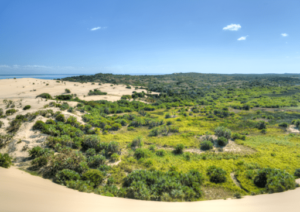 Declared a National Park in 1971, the Bazaruto Archipelago has a unique natural ecosystem linked to its isolation: forest, savannah, lakes, ponds and marshes which safeguard a diversified fauna and flora. From the 15th century, they were renowned for their pearls and ambergris.
Declared a National Park in 1971, the Bazaruto Archipelago has a unique natural ecosystem linked to its isolation: forest, savannah, lakes, ponds and marshes which safeguard a diversified fauna and flora. From the 15th century, they were renowned for their pearls and ambergris.
Bazaruto, the largest island in the archipelago, gave the archipelago its name. 32.5 km long and 5 km wide, it is made up of imposing dunes and inland lakes. A century-old lighthouse helps boats.
Benguerra, located 1 km south of Bazaruto, is about 12 km long. Covered with high dunes, inland lakes and beautiful beaches. Squirrels, monkeys and 164 species of birds live in small native forests. The "Two miles" reef, world famous for diving, is located 2 km east of Benguerra.
Magaruque, 5.5 kilometers from Benguerra, is much smaller. It offers good snorkeling to the southwest. Going around it is pleasant and only takes a few hours.
Santa Carolina, the island of paradise, is the jewel of the archipelago, the only coral island of the archipelago. Coral reefs are within palm reach. Clear waters over 2.3 km in length!
Bangue, tiny, is uninhabited. 3,500 Mozambicans reside on the other 4 islands.
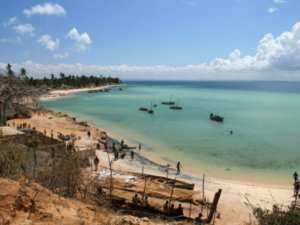 The city is renowned for its Portuguese colonial architecture. In the center of Pemba, a local market offers arts and crafts products, such as traditional silverware. Located in Pemba Bay, the town has always been quite far from the main trade routes, which has allowed it to preserve its natural beauty. Wimbe beach is one of the most beautiful in Mozambique. Pemba is popular with scuba diving enthusiasts due to the coral reefs that lie near the coast.
The city is renowned for its Portuguese colonial architecture. In the center of Pemba, a local market offers arts and crafts products, such as traditional silverware. Located in Pemba Bay, the town has always been quite far from the main trade routes, which has allowed it to preserve its natural beauty. Wimbe beach is one of the most beautiful in Mozambique. Pemba is popular with scuba diving enthusiasts due to the coral reefs that lie near the coast.
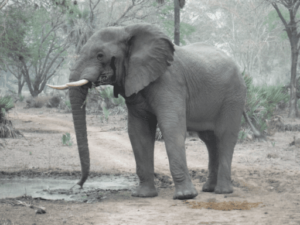 Le Parc National de Gorongosa ( mont à 1 862m) offre une grande variété de paysages due à sa topographie spécifique : forêts tropicales, plaines arides, caldeiras, hauts plateaux, chutes d’eau et falaises verticales.
Le Parc National de Gorongosa ( mont à 1 862m) offre une grande variété de paysages due à sa topographie spécifique : forêts tropicales, plaines arides, caldeiras, hauts plateaux, chutes d’eau et falaises verticales.
After bloody wars, Gorongosa is gradually regaining its former splendor. You will see elephants, many species of antelope, wildebeest, warthogs, monkeys and nearly 500 species of wonderful birds. The lion population is growing, as is that of the wild dogs reintroduced to the park in 2018. Zebras, buffaloes and leopards are more easily visible. Nocturnal species include serval, genet, porcupine, civet.
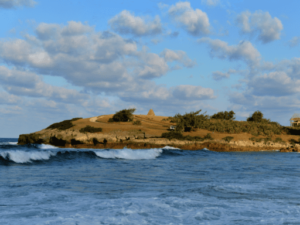 Tofo is a small town in southwestern Mozambique. The city is located on the peninsula of Ponto do Barra, in the province of Inhambane, 22 km from the city of Inhambane. Formerly a fishing village, Tofo has a hotel and three scuba diving clubs to welcome tourists attracted by the coastline and the nearby reefs which are teeming with life. With its whale sharks, manta rays and sea turtles, Tofo is a top destination for ecotourism.
Tofo is a small town in southwestern Mozambique. The city is located on the peninsula of Ponto do Barra, in the province of Inhambane, 22 km from the city of Inhambane. Formerly a fishing village, Tofo has a hotel and three scuba diving clubs to welcome tourists attracted by the coastline and the nearby reefs which are teeming with life. With its whale sharks, manta rays and sea turtles, Tofo is a top destination for ecotourism.
The park protects 913,000 hectares of coastal forests, mangroves and coral reefs. On land, there are sparse populations of elephants, lions, leopards, crocodiles and even wild dogs. Habitats include mountains, forests, woodlands, savannah, mangroves, beaches, coral reefs, and seagrass beds. The park contains a rich variety of marine life, including sea turtles, dolphins, and many species of fish. 375 species of fish have been identified, including endangered pipefish and seahorses.
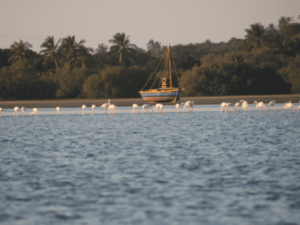 Originally the territory of the Tsongas, a Banto tribe, the island of Inhaca welcomed a population of fishermen when the Portuguese arrived in the 16th century. The island of Inhaca preserves the diversity of its seabed with its 150 species of corals, its 300 species of birds present on the island. Do not deprive yourself of the pleasure of diving in these limpid waters at 25°C with turtles and clown fish!
Originally the territory of the Tsongas, a Banto tribe, the island of Inhaca welcomed a population of fishermen when the Portuguese arrived in the 16th century. The island of Inhaca preserves the diversity of its seabed with its 150 species of corals, its 300 species of birds present on the island. Do not deprive yourself of the pleasure of diving in these limpid waters at 25°C with turtles and clown fish!
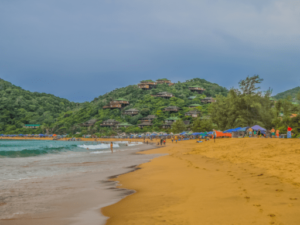 Ponta do Ouro (La Pointe d’or ) is a seaside resort located in southern Mozambique, in the province of Maputo, 15 kilometers from the border with South Africa. It takes its name from a cape whose beaches are at the origin of its notoriety. This site is particularly famous for dolphin watching and scuba diving.
Ponta do Ouro (La Pointe d’or ) is a seaside resort located in southern Mozambique, in the province of Maputo, 15 kilometers from the border with South Africa. It takes its name from a cape whose beaches are at the origin of its notoriety. This site is particularly famous for dolphin watching and scuba diving.
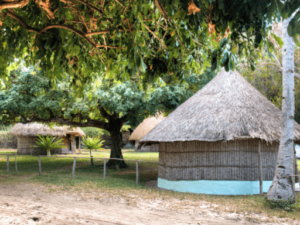 Also called Vilankulo, the city of Vilanculos is typed with its typical houses and streets. It takes its name from the tribal chief Gamela Vilankulo Mukoke. Some of the quarters of the city, or some of the places in its suburbs, bear the names of the sons of Gamela. In addition, the island changed its name according to the periods: Vilanculos during the colonial period, then Vilankulo once independence was acquired. The town of Vilankulo is the gateway to the Bazaruto Archipelago.
Also called Vilankulo, the city of Vilanculos is typed with its typical houses and streets. It takes its name from the tribal chief Gamela Vilankulo Mukoke. Some of the quarters of the city, or some of the places in its suburbs, bear the names of the sons of Gamela. In addition, the island changed its name according to the periods: Vilanculos during the colonial period, then Vilankulo once independence was acquired. The town of Vilankulo is the gateway to the Bazaruto Archipelago.
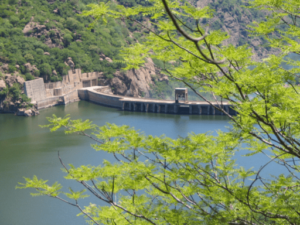 The Cahora Bassa is a dam lake in the province of Tete. The reservoir is approximately 2,574 km² which thus regulates navigation over 250 km and allows fishing and irrigation downstream for cotton, sugar cane and citrus plantations.
The Cahora Bassa is a dam lake in the province of Tete. The reservoir is approximately 2,574 km² which thus regulates navigation over 250 km and allows fishing and irrigation downstream for cotton, sugar cane and citrus plantations.
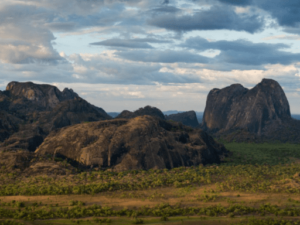 Located in northern Mozambique, the Niassa Reserve is the largest protected area in the country. In total, Niassa covers 42,000 square kilometers. In other words, the equivalent of the surface of Wales or Denmark. This natural space founded in 1954 has fully suffered the civil war in Mozambique, and in particular poaching. Still in the reconstruction phase, Niassa welcomes you in a wild environment.
Located in northern Mozambique, the Niassa Reserve is the largest protected area in the country. In total, Niassa covers 42,000 square kilometers. In other words, the equivalent of the surface of Wales or Denmark. This natural space founded in 1954 has fully suffered the civil war in Mozambique, and in particular poaching. Still in the reconstruction phase, Niassa welcomes you in a wild environment.
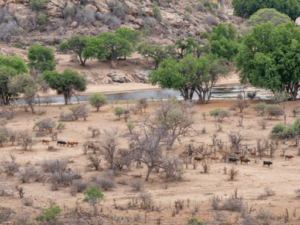 Gonarezhou National Park in Zimbabwe, Kruger National Park in South Africa and Limpopo National Park in Mozambique form a vast nature reserve called Limpopo Transfrontier Park. Its 35,000 km2 are home to extraordinary biodiversity, including the presence of the famous Big 5: buffaloes, lions, elephants, leopards and rhinos. The three parks are grouped together with the objective of peace and development. People are encouraged to produce the resources and the animals have a large area where they can easily hide.
Gonarezhou National Park in Zimbabwe, Kruger National Park in South Africa and Limpopo National Park in Mozambique form a vast nature reserve called Limpopo Transfrontier Park. Its 35,000 km2 are home to extraordinary biodiversity, including the presence of the famous Big 5: buffaloes, lions, elephants, leopards and rhinos. The three parks are grouped together with the objective of peace and development. People are encouraged to produce the resources and the animals have a large area where they can easily hide.
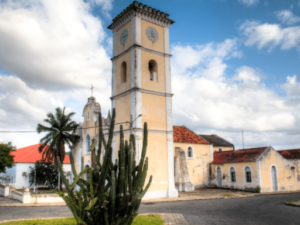 Inhambane is one of the oldest settlements on the coast of Mozambique. Dhows came to trade there from the 11th century. Muslims and Persian traders came here to negotiate ambergris and pearls and went to trade further south, in Chibuene. The region was known for its cotton yarn productions made by the Tonga. Shortly before the Portuguese discovered the city, the Karangas had conquered Inhambane and subjugated a number of local chieftains who dominated the Tonga cotton workers and were rewarded for trading with the Muslims.
Inhambane is one of the oldest settlements on the coast of Mozambique. Dhows came to trade there from the 11th century. Muslims and Persian traders came here to negotiate ambergris and pearls and went to trade further south, in Chibuene. The region was known for its cotton yarn productions made by the Tonga. Shortly before the Portuguese discovered the city, the Karangas had conquered Inhambane and subjugated a number of local chieftains who dominated the Tonga cotton workers and were rewarded for trading with the Muslims.
When Vasco da Gama circumnavigated Africa, in 1498, he called at Inhambane to replenish his supplies and make explorations. He immediately liked Imhambane and named her Terra de Boa Gente ("Land of the Gentle People").
 Since 2008, the park has been reviving thanks to the mobilization of scientists from all over the world and especially to a key man who brought them here: Gregory C. Carr, an American philanthropist and entrepreneur. You can see impalas, hippos, and a few elephants.
Since 2008, the park has been reviving thanks to the mobilization of scientists from all over the world and especially to a key man who brought them here: Gregory C. Carr, an American philanthropist and entrepreneur. You can see impalas, hippos, and a few elephants.
The elephant reserve, about 30 kilometers south of Maputo, The remaining resident elephant population in the Maputo Special Reserve was able to survive the civil war and is now thriving, with the latest game count revealing a population of over 400 elephants that graze in large herds on open floodplains or explore thick dune forests.
 In the north of the country, the Niassa reserve
In the north of the country, the Niassa reserve The reserve is one of the largest miombo woodland reserves in the world, with miombo forest covering half of the reserve. The rest is mostly open savannah, with some wetlands and isolated patches of forest.
Niassa Reserve is home to an African wild dog population of over 350, significant for an endangered mammal with an estimated global population of 8,000. The park is home to a sable antelope population of over 12,000, a elephant population of 16,000, over 400 bird species and large populations. Cape buffaloes, impalas, wildebeests, zebras and leopards. The area has three endemic species – Niassa's Wildebeest, Boehm's Zebra and Johnston's Impala.
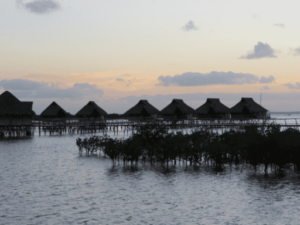 Inside, the hiking trails are cut through the wild bush, in the heart of the natural environment of the paradise of the 775 species of birds of Mozambique!
Inside, the hiking trails are cut through the wild bush, in the heart of the natural environment of the paradise of the 775 species of birds of Mozambique!
The coast is the kingdom of the mangrove. An accumulation of mangrove trees with exposed roots grows in shallow water. The mangrove plays its role as a powerful natural filter and provides fresh water to many villages, in particular by evacuating salt through its leaves, for example on the island of Inhaca.
Mangroves have the ability to filter impurities, leaving waters of absolute transparency and paradisiacal beaches.
Further north, on the Quirimbas archipelago, the hikes are fantastic. The mangrove can be crossed on foot at low tide or by boat at high tide. All these roots that mingle and intertwine, as if the trees were suddenly going to start walking.
Mozambique is also dunes, sandbanks that make up the coastal landscape. The Zambezi Company, at the time of Portuguese domination, established vast plantations of coconut palms and cultivated sugar. The planted coconut palms still draw the coast, even if they suffer a lot more and more from the storms.
Mozambique has few trains. Rail traffic is reduced to a strict minimum and is mainly used to transport goods
There are, however, a few exceptions to note.
The train between Maputo and Johannesburg (600 km, 14 hours of travel) offers a fairly pleasant journey, with its "little comfort" and the view of magnificent wild scenery.
The journey that connects Nampula to Cuamba, several times a week, in 10 hours, offers splendid landscapes and constitutes a good alternative to the road.

Attention, as in neighboring countries, we drive on the left in Mozambique. The international driving license is mandatory, and insurance is essential. For the rental of a 4×4, the price easily rises to 1,200 US$ per week, against 400 to 500 € for a sedan. International rental companies like Hertz, Europcar or Avis are represented in Maputo.
The road along the coast is paved and in fairly good condition, but on the rest of the network, the track predominates. The 4×4 is then necessary. After the rain, the tracks become almost impassable. As soon as you leave the cities, there are hardly any road signs.
For safety reasons, absolutely avoid driving at night. In general, beware of chapas and buses that will not hesitate to overtake you cheerfully. Accidents are numerous, especially on the EN1 which connects the north to the south of the country. Beware of people who regularly cross the main roads without looking. Finally, beware of the animals: the risk is great of having to pound in front of a stunned goat!
Please note that gas stations are sometimes spaced several hundred kilometers apart. So don't hesitate to fill up at the station that comes along.
Find more updated information on Tourism in Mozambique in our Blog Tourismer.io

A non-profit organization whose activities are based on the experience and learning of various civil society organizations such as ESSOR, CCM, OASIS, PNDH, Zambeze University for several years acting in Sofala Province, Mozambique taking into account the Government's action priorities in the area of Social Protection.
In Guinea-Bissau, Mozambique and the Republic of Congo, the peri-urban areas of large cities have strong agricultural potential hampered by common problems: insufficient training and means; excessive and uncontrolled use of chemicals harmful to the environment and health safety; difficulties in accessing quality inputs; land pressure; fertility problems; difficulties in promoting and accessing markets for local products in the face of imported products, etc.
Increasing agricultural productivity is however one of the priorities of the governments of these 3 countries in order to achieve food self-sufficiency, even though populations are constantly growing and the effects of climate change are negatively impacting agriculture and threatening food safety. Faced with these challenges, ESSOR and its partners propose to strengthen the skills and resilience of vulnerable producers, through practices that are more productive, more profitable, and more respectful of the environment (promotion of agroecology) .